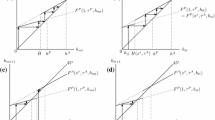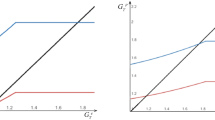Abstract
As of the late 1990s, public spending on education in the US comprised approximately 7.1% of GDP; about 60% of that support was directed at K-12 education and the remainder at college education. We investigate the welfare and output implications of this spending in a theoretical model in which agents of differential innate ability choose whether to pursue higher education. Higher ability agents support greater expenditures at both the K-12 and college levels. When public education expenditures are low, all agents prefer that spending be directed solely to K-12 education; when expenditures are high, all prefer that some spending be allocated to college education.
Similar content being viewed by others
References
Akyol A., Athreya K. (2005) Risky higher education and subsidies. J Econ Dyn Control 29, 979–1023
Barro R. (1990) Government spending in a simple model of endogenous growth. J Polit Econ 98, S103–S125
Becker G. (1964) Human capital: a theoretical and empirical analysis, with special reference to education, 3rd edn. University of Chicago Press, Chicago
Benabou R. (1996) Heterogeneity, stratification, and growth: macroeconomic implications of community structure and school finance. Am Econ Rev 86, 584–609
Benabou R. (2002) Tax and education policy in a heterogeneous-agent economy: what levels of redistribution maximize growth and efficiency. Econometrica 70, 481–517
Ben-Porath Y. (1967) The production of human capital and the life cycle of earnings. J Polit Econ 75, 352–365
Blankenau W. (1999) A welfare analysis of policy responses to the skilled wage premium. Rev Econ Dyn 2, 820–849
Blankenau W. (2005) Public schooling, college subsidies and growth. J Econ Dyn Control 29, 487–507
Blankenau W., Simpson N. (2004) Public education expenditures and growth. J Dev Econ 73, 583–605
Card D., Krueger A. (1992) Does school quality matter? Returns to education and the characteristics of public schools in the United States. J Polit Econ 100, 1–40
Cassou S.P., Lansing K.J. (2004) Growth effects of shifting from a graduated-rate tax system to a flat tax. Econ Inq 42, 194–213
Cassou S.P., Lansing, K.J. Tax reform and useful public expenditures. J Publ Econ Theory (in press) (2006)
Caucutt E., Kumar K. (2003) Higher education subsidies and heterogeneity: a dynamic analysis. J Econ Dyn Control 27, 1459–1502
Creedy J., Francois P. (1990) Financing higher education and majority voting. J Publ Econ 43, 181–200
Eckstein Z., Zilcha I. (1994) The effects of compulsory schooling on growth, income distribution and welfare. J Publ Econ 55, 339–359
Fender J., Wang P. (2003) Education policy in a credit constrained economy with skill heterogeneity. Int Econ Rev 44, 939–964
Fernandez R., Rogerson R. (1995) On the political economy of education subsidies. Rev Econ Stud 62, 249–262
Fernandez R., Rogerson R. (1999) Education finance reform and investment in human capital: lessons from California. J Publ Econ 74, 327–350
Fernandez R., Rogerson R. (2003) Equity and resources: an analysis of education finance systems. J Polit Econ 111, 858–897
Galor O., Moav O. (2000) Ability-biased technological transition, wage inequality, and economic growth. Q J Econ 115, 469–497
Glomm G., Kaganovich M. (2003) Distributional effects of public education in an economy with public pensions. Int Econ Rev 44, 917–937
Glomm G., Ravikumar B. (1992) Public versus private investment in human capital: endogenous growth and income inequality. J Polit Econ 100, 818–834
Glomm G., Ravikumar B. (1997) Productive government expenditures and long-run growth. J Econ Dyn Control 21, 183–204
Glomm G., Ravikumar B. (1998) Flat-rate taxes, government spending on education, and growth. Rev Econ Dyn 1, 306–325
Glomm G., Ravikumar B. (2001) Human capital accumulation and endogenous public expenditures. Can J Econ 34, 807–826
Hanushek E., Ka Yui Leung C., Yilmaz K. (2003) Redistribution through education and other transfer mechanisms. J Monetary Econ 50, 1719–1750
Johnson G. (1984) Subsidies for higher education. J Labor Econ 2, 303–318
Kaganovich M., Zilcha I. (1999) Education, social security and growth. J Publ Econ 71, 289–309
Katz L., Murphy K. (1992) Changes in relative wages, 1963–1987: supply and demand factors. Q J Econ 107, 35–78
Krusell P., Ohanian L., Rios-Rull J., Violante G. (2000) Capital-skill complementarity and inequality: a macroeconomic analysis. Econometrica 68, 1029–1053
Loury G. (1981) Intergenerational transfers and the distribution of earnings. Econometrica 49, 843–867
Milesi-Ferretti G., Roubini N. (1998) On the taxation of human and physical capital in models of endogenous growth. J Publ Econ 70, 237–254
Rangazas P. (2000) Schooling and economic growth: a King–Rebelo experiment with human capital. J Monetary Econ 46, 397–416
Restuccia D., Urrutia C. (2004) Intergenerational persistence of earnings: the role of early and college education. Am Econ Rev 94, 1354–1378
Soares J. (2003) Self-interest and public funding of education. J Publ Econ 87, 703–727
Su X. (2004) The allocation of public funds in a hierarchical educational system. J Econ Dyn Control 28, 2485–2510
Author information
Authors and Affiliations
Corresponding author
Rights and permissions
About this article
Cite this article
Blankenau, W., Cassou, S.P. & Ingram, B. Allocating Government Education Expenditures Across K-12 and College Education. Economic Theory 31, 85–112 (2007). https://doi.org/10.1007/s00199-006-0084-8
Received:
Accepted:
Published:
Issue Date:
DOI: https://doi.org/10.1007/s00199-006-0084-8




